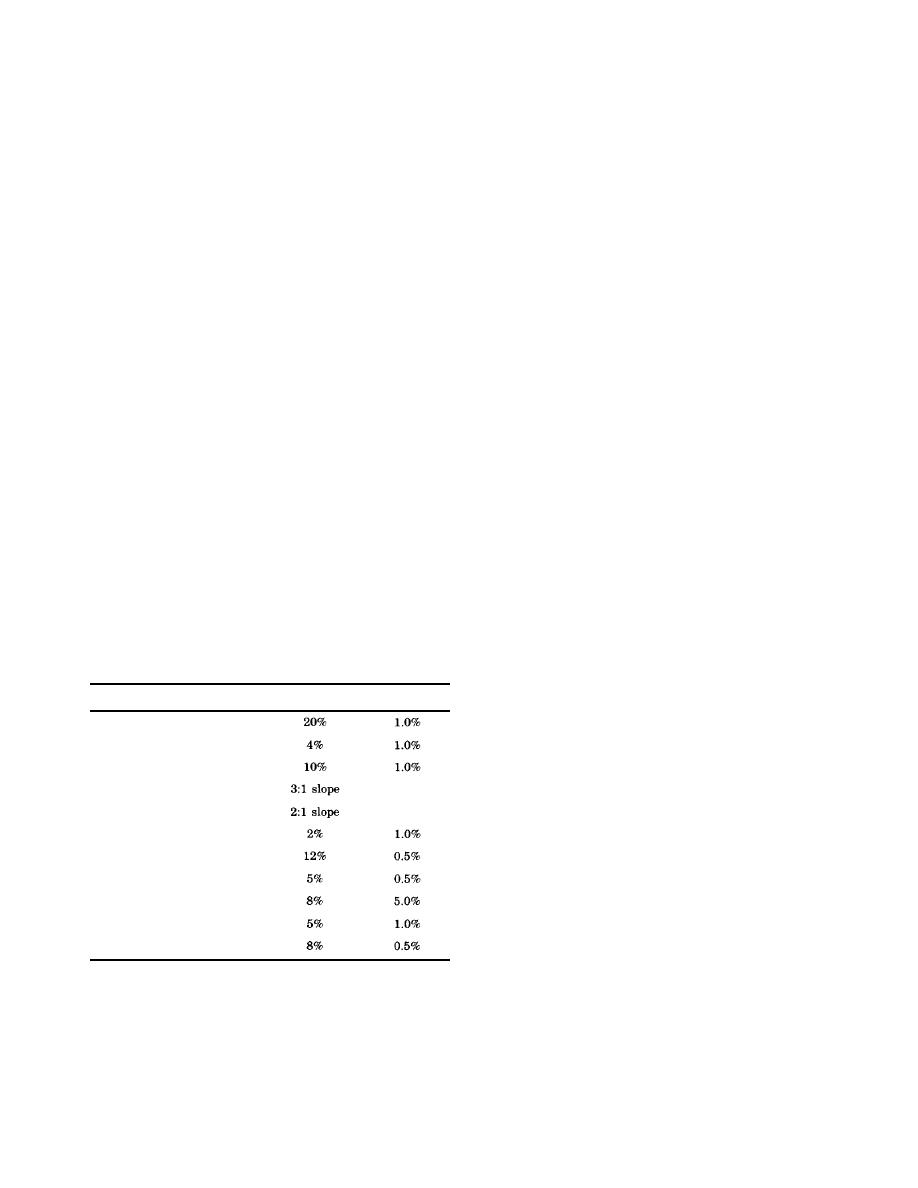
TM 5-803-14
(b) Providing adequate space for people to
ate slopes, this usually requires some terracing as
concentrate outside of the pedestrian traffic flow.
illustrated in figure 4-12. Slab-on-grade is the
(c) Locating areas for people to sit on the
most economical and, therefore, predominant
dge or outside of the pedestrian flow.
building type, especially on flat sites. To balance
(d) Providing both shaded and sunny areas
cut and fill, these structures are often sited diago-
for people to congregate or sit.
nally to the slope. Figure 4-13 illustrates the
(4) Troop Formation Areas. Installations with
following building types which respond to steeper
training facilities require walkways for troops
topographic situations.
marching in formation between classrooms, bar-
(a) Fall-away structures locate the front of
racks, dining halls and parade grounds. These
the building at one elevation, lower the grade
walkways should be wide enough to accommodate
down the sides, and locate the back of the building
at a lower elevation. Fall-away buildings can be
personnel walking four abreast. They should be
used on grades ranging from 5 to 10%.
hard-surface.
(b) Cantilevered buildings allow existing
4 - 4 . Grading.
grade to remain substantially unaltered while the
a. General. Existing and proposed topography on
building is suspended in air, supported by a
site can serve many purposes including the follow-
vertical structure installed into the substrate. Can-
ing:
tilevered buildings can be used on extremely steep
(1) Emphasizing the prominence of facilities.
slopes, up to about 18%.
(2) Secluding and sheltering facilities.
(c) Earth-sheltered buildings use existing or
created slopes or berms to insulate the structure.
(3) Helping to direct vehicular and pedestrian
(2) Floor Elevations. Finished or first floor
flows.
elevations of buildings will be set a minimum six
(4) Managing site runoff.
inches above adjacent outdoor grade. The finished
(5) Screening undesirable views or activities.
floor elevation will be set to provide positive
(6) Creating a more interesting natural char-
drainage around the entire perimeter of the build-
acter.
ing. The correct setting of this elevation is critical
b. Standard Desirable Slopes. Grading should
to a good grading plan. The building must not be
maintain existing topography while recognizing
placed too low in relation to the rest of the site.
standard gradients for various functions and activ-
Where outdoor entrances (e.g., basement exits),
ities. Table 4-1 provides standard desirable slopes
occur below finished elevation, additional provi-
for various land uses.
sions, such as drain inlets, will be made to provide
drainage. Access and utility service should also be
Table 4--1. Standard Desirable Slopes
considered when setting the finished floor eleva-
Area Title
Maximum
Minimum
tion.
Lawn Areas
(3) Outside Finished Grade. Outside finished
grade should normally slope away from the build-
Playing Fields
ing at a minimum five percent slope for approxi-
Swales
mately 10'. Where topography is too steep or space
Grass Banks
between buildings is too limited to maintain such
Ground Cover Banks
a large area around the building, the slope of the
outside finished grade can be increased. Additional
Courtyards and Entryways
drainage structures, such as yard inlets, will be
Sidewalks
provided.
Barrier-Free Walks
d. Circulation. Grading for vehicular routes, pe-
Barrier-Free Ramps
destrian routes, and parking areas should respond
to existing topography.
Parking Areas
(1) Vehicular Circulation. Roads and drives
Roads and Drives
should be laid out to traverse the topography as
c. Buildings.
closely as possible to existing grade, within the
(1) Siting. Building orientation may be influ-
standard grade limits. This reduces the amount of
enced by existing topography as well as the solar
earthwork. Maximum grades are determined by
conditions determined in the solar study. Gener-
the types of vehicles using the road and its design
ally, the best orientation for buildings is parallel
speed. Maximum grades are influenced by local
to slope. Buildings may also be located with their
weather conditions and practice. To the extent
long axis perpendicular to grade. Even on moder-
possible, the profile of a road or drive should
4-11



 Previous Page
Previous Page
